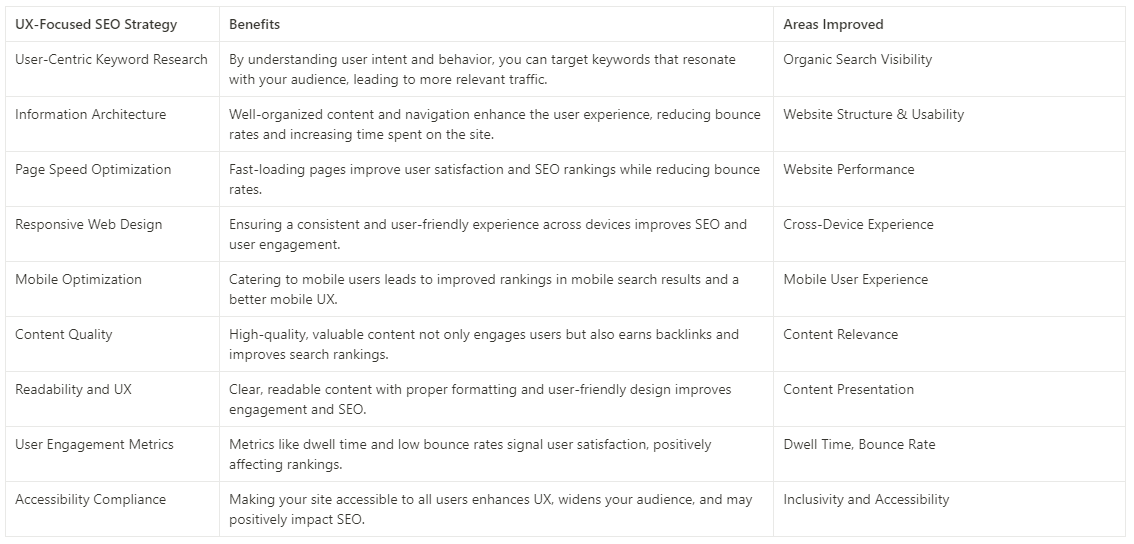Does UX Affect SEO?
The Impact of UX on Search Engine Optimization(SEO)
"First impressions matter," and in the world of digital landscapes, it couldn't be more accurate. When a user lands on your website, you have just a few seconds to capture their attention and make them stay. In that fleeting moment, the harmony between User Experience (UX) and Search Engine Optimization (SEO) comes into play.
In this edition, we'll explore how crafting an exceptional user experience can be the key to unlocking higher search engine rankings, better engagement, and ultimately, soaring success for your online presence.
'“A well-designed and user-friendly website is likely to perform better in search results and attract more visitors, which aligns with both user preferences and search engine algorithms.”
Applying User Experience (UX) principles to elevate and optimize SEO involves ensuring that your website is not only search engine-friendly but also user-friendly.
Step 1: Prioritize User Experience (UX)
Imagine your website as a cozy bookstore. Just as in our lovely bookstore scenario, user experience is everything. Here's how to do it online:
Mobile Friendliness: Most FTT(First Time Traffic) come through the mobile device. Ensure your website responds and works great on mobile devices. Google rewards mobile-friendly sites.
Speed Matters: Slow-loading pages frustrate users and Google takes note. So, optimize your site's speed for better SEO.
Step 2: Craft Content for Humans and Keywords
Great stories (content) attract readers (users) and search engines. Here's the plan:
Quality Content: Create content that's informative, engaging, and nicely organized. When users stay longer, it tells search engines your content is valuable.
Keyword Know-How: Understand what your audience searches for. Use keywords naturally in your content, headings, and meta descriptions.
Step 3: Map a Smooth User Journey
Clear Navigation: Make your site easy to navigate. Users should find what they need without frustration.
Internal Links: Just as the bookstore has signs pointing to related genres, link-related pages within your site. It helps users explore more and boosts SEO.
Clear call-to-action: Well-defined and strategically placed call-to-action buttons guide users towards desired actions, such as making a purchase or signing up.
Step 4: Build User Trust and Credibility
Trust is essential, both for users and search engines:
Secure Connection: Use HTTPS to secure your website. Google likes secure sites.
About and Contact Pages: These are like the store owner's introduction. Include them. It builds trust with users and search engines alike.
Step 5: Design with Mobile in Mind
With everyone on their phones, it's like most of your customers are reading on the go:
Responsive Design: Ensure your site looks great and functions smoothly on mobile devices.
Scenario: A UX Approach to Optimizing SEO.
Let’s assume you are hired to work on a website with bad SEO and is poorly ranked on search engines. To improve the SEO of that website, it's essential to strike a balance between enhancing user experience and optimizing for search engines. Here's an 8 step-by-step strategy to achieve this:
1. Website Audit:
- Begin with a comprehensive audit of the website's current SEO status. Identify strengths, weaknesses, and areas that need improvement.
- Analyze user behavior using tools like Google Analytics to understand user journeys, popular pages, and exit points.
2. Keyword Research:
- Perform keyword research to identify relevant keywords and phrases your target audience uses. Focus on long-tail keywords and consider user intent.
- Map keywords to specific pages or content on your website.
3. Content Optimization:
- Review and optimize existing content. Ensure each page has a clear focus on specific keywords while maintaining readability and user value.
- Add internal links to relevant content, aiding navigation and SEO.
4. Mobile Optimization:
- Ensure the website is fully responsive and optimized for mobile devices, as Google gives preference to mobile-friendly sites.
5. Page Speed Improvement:
- Optimize images and implement browser caching to enhance page load speed.
- Minimize HTTP requests and enable compression for faster load times.
6. UX Enhancements:
- Implement a user-friendly navigation structure with clear menus, breadcrumbs, and logical categorization to improve user experience.
- Ensure proper use of headings, subheadings, bullet points, and short paragraphs for readability.
7. User Engagement Metrics:
- Monitor user engagement metrics like dwell time, bounce rate, and click-through rate to assess improvements and adjust strategies accordingly.
8. User Feedback:
- Gather user feedback through surveys, usability testing, and user interviews to continually improve the user experience.
Ready to Boost Your SEO with UX Magic?
Discover more ways to enhance your website's UX and SEO in our advanced search engine for digital marketers and UX enthusiasts.
Use the discount code RBM23 during checkout
Recommended Tools to Kickstart Your SEO Journey
Google's Mobile-Friendly Test: Check if your site is mobile-friendly.
PageSpeed Insights: Analyze your website's speed and get suggestions for improvement.
Moz's Keyword Explorer: A tool to help you find the right keywords for your content.
As you embark on this journey, remember that creating a user-friendly website is like opening the doors to an inviting bookstore. Both users and search engines will thank you for it.
Happy optimizing!
Warm regards,


